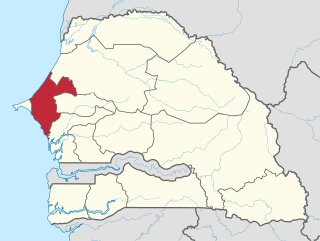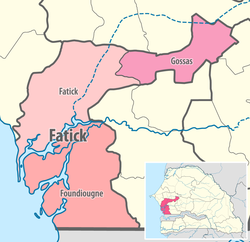
Thiès is a region of western Senegal. The capital is also called Thiès.

The Diourbel Region is a region of Senegal with 2,080,811 inhabitans (2023). The regional capital is the city of Diourbel. The region corresponds roughly to the precolonial Kingdom of Bawol and is still called by that name. Bawol is an ancient kingdom formerly ruled by the Joof family, one of the members of the Serer ethnic group found in Senegambia. Inhabitants of the area are called Bawol-Bawol which takes its name from the Serer mode of pluralisation, other examples being : Sine-Sine or Siin-Siin, Saloum-Saloum, etc. The population is primarily comprised by the Serer people especially those from the Cangin group, the Safene in particular. The Serers are believed to be the original inhabitants of this area. The Wolof and other ethnic groups are also present. The Diourbel Region is rich in history and it is where the Cekeen Tumulus are located. Scholars such as Charles Becker, Henry Gravrand, and Victor Martin suggest that these monuments were built by the Serer people and form part of the Serer tumulus of Baol. They are some of the most sacred sites in Serer religion. The Département of Mbacke also includes Murid Islamic Sufi order's holy city of Touba. The installation of this order in Serer country is a controversial one, especially among those Serers who adhere to the tenets of Serer religion (see Serer history. However, some Serers are also Muslims and have headed this religious order.
Mamadu Diakhou Bâ, also known as Maba Jahou Bah, Ma Ba Diakhu, Ma Ba Diakho Ba, Ma Ba Jaaxu, Mabba Jaxu Ba, was a Muslim leader in West Africa during the 19th century. He was a disciple of the Tijaniyya Sufi brotherhood and became the Almami of Saloum.

The Kingdom of Sine was a post-classical Serer kingdom along the north bank of the Saloum River delta in modern Senegal. The inhabitants are called Siin-Siin or Sine-Sine.
Fatick is a town in Senegal, located between M'bour and Kaolack and inhabited by the Serer people. Its 2005 population was estimated at 24,243. It is the capital of the Fatick Region and the Fatick Department.
The French conquest of Senegal started in 1659 with the establishment of Saint-Louis, Senegal, followed by the French capture of the island of Gorée from the Dutch in 1677, but would only become a full-scale campaign in the 19th century.

The Saltigue, are Serer high priests and priestesses who preside over the religious ceremonies and affairs of the Serer people, such as the Xooy ceremony, the biggest event in the Serer religious calendar. They usually come from ancient Serer paternal families. Such a title is usually inherited by birthright. In Serer country, Saltigue are always diviners. The scope of this article deals only with the Serer Saltigues – "diviners" and termed by some scholars as "the ministers of the religious cult"; "pastors of the people" or within the remits of these definitions.
The Serer religion, or a ƭat Roog, is the original religious beliefs, practices, and teachings of the Serer people of Senegal in West Africa. The Serer religion believes in a universal supreme deity called Roog. In the Cangin languages, Roog is referred to as Koox, Kopé Tiatie Cac, and Kokh Kox.

The Battle of Fandane-Thiouthioune, also known as the Battle of Somb or the Battle of Somb-Tioutioune, occurred on 18 July 1867. It was a religious war between the Serer people and the Muslim Marabouts in 19th-century Senegal and the Gambia, but it also had a political and economic dimension to it: vendetta and empire-building. Fandane, Thiouthioune and Somb were part of the pre-colonial Serer Kingdom of Sine, now part of independent Senegal.
Guelowar, also spelled Gelwar, Guelwar, Guelware, Gueleware or Gueloware, was a maternal dynasty in the pre-colonial Serer kingdoms of Sine and Saloum. They were from the Mandinka ethnic group. The offspring of Mandinka women and Serer men became the kings of Sine and Saloum. The dynasty lasted from the mid-14th century to 1969, the year both kings died.
Somb is a town in Senegal situated in the west of the country.

The prehistoric and ancient history of the Serer people of modern-day Senegambia has been extensively studied and documented over the years. Much of it comes from archaeological discoveries and Serer tradition rooted in the Serer religion.

The medieval history of the Serer people of Senegambia is partly characterised by resisting Islamization from perhaps the 11th century during the Almoravid movement, to the 19th century Marabout movement of Senegambia and continuation of the old Serer paternal dynasties.

Joof or Diouf is a surname that is typically Serer. This surname is also spelt Juuf or Juf.
This is a timeline of the history and development of Serer religion and the Serer people of Senegal, The Gambia and Mauritania. This timeline merely gives an overview of their history, consisting of calibrated archaeological discoveries in Serer countries, Serer religion, politics, royalty, etc. Dates are given according to the Common Era. For a background to these events, see Roog, Serer religion, Serer creation myth, Serer prehistory, Lamane, States headed by Serer Lamanes, Serer history and Serer people.

The Battle of Logandème was an uprising led by the Serer King Maad a Sinig Kumba Ndoffene Famak Joof, king of Sine, against the French Empire. The battle took place at Logandème which was a part of Sine at the time. The battle was also a revenge attack against the Serer people after their resounding victory against France at the Battle of Djilass on 13 May 1859. It was the first time that France decided to employ cannonball in the Senegambia.
Maad a Sinig Maysa Wali Jaxateh Manneh was a king described in the oral tradition of the Serer pre-colonial Kingdom of Sine and the first of the Guelowar maternal dynasty to rule in Serer country. He reigned as Maad a Sinig from c. 1350 to 1370.
Serer maternal clans or Serer matriclans are the maternal clans of the Serer people of Senegal, the Gambia and Mauritania. The Serer are both patrilineal and matrilineal. Inheritance depends on the nature of the asset being inherited – i.e. whether it is a maternal asset which requires maternal inheritance or paternal asset requiring paternal inheritance (kucarla). The Serer woman play a vital role in royal and religious affairs. In pre-colonial times until the abolition of their monarchies, a Serer king would be required to crown his mother, maternal aunt or sister as Lingeer (queen) after his own coronation. This re-affirms the maternal lineage to which they both belong (Tim). The Lingeer was very powerful and had her own army and palace. She was the queen of all women and presided over female cases. From a religious perspective, the Serer woman plays a vital role in Serer religion. As members of the Serer priestly class, they are among the guardians of Serer religion, sciences, ethics and culture. There are several Serer matriclans; not all of them are listed here. Alliance between matriclans in order to achieve a common goal was, and still is very common. The same clan can be called a different name depending on which part of Serer country one finds oneself in. Some of these matriclans form part of Serer mythology and dynastic history. The mythology afforded to some of these clans draws parallels with the Serer creation narrative, which posits that: the first human to be created was a female. Many Serers who adhere to the tenets of Serer religion believe these narratives to contain profound truths which are historic or pre-historic in nature.
Babacar Sedikh Diouf or Babacar Sédikh Diouf is a Senegalese historian, author, researcher, campaigner against "Wolofization", a Pan-Africanist, and former teacher. He has written extensively about the history and culture of Senegal, Africa, and that of the Serer ethnic group to which he belongs. He usually writes by the pen name Babacar Sedikh Diouf.
The Xooy is a Serer divination ceremony held once a year in Fatick, Senegal. The Xooy is one of the most important and well known ceremonies in the Serer religious calendar, and is a national event in Senegal's cultural calendar which attracts government officials and dignitaries. The ceremony is held yearly at the Centre MALANGO in Sine, Senegal and attracts a large crowd from Senegal, and Serers from neighbouring Gambia and the diaspora. It is somewhat of a yearly pilgrimage. The Lebou also attend the ceremony in homage to their Serer ancestors. The Lebou genies are actual the Serer pangool. The Xooy takes place around late May early June before the rainy season where the Serer high priests and priestesses—the Saltigue dressed in their traditional gowns and hats takes centre stage to divine the future. There is a master of ceremonies, and as the public are seated in a circle, each Saltigue enters the circle in turn and give their divination on matters relating to the weather, politics, economics, health, etc. The ceremony goes on for two days —and throughout the night—accompanied by the rhythm of drums. The Serer people have traditionally been farmers, cattle herders, boat builders and fisher people. The Xooy therefore serves both a religious and agricultural function.










